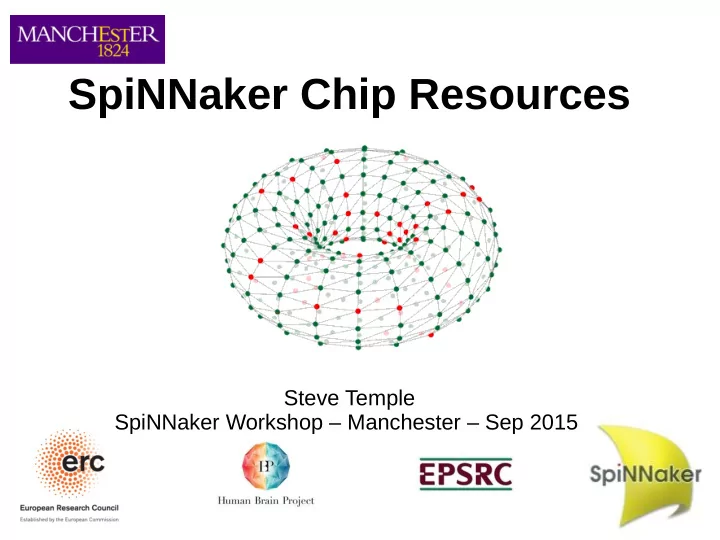

SpiNNaker Chip Resources Steve Temple SpiNNaker Workshop – Manchester – Sep 2015
Overview ● Chip Architecture ● Core Architecture ● Low-level Communication ● Packet formats ● Multicast routing ● High-level Communication – SDP ● Hardware Limitations Please interrupt if you have a question!
SpiNNaker Chip Outline
Chip Interconnect
SpiNNaker Chip Details
SpiNNaker Chip Layout ● 130nm process ● 10 x 10 mm ● 18 ARM cores with 96K SRAM ● Router ● SDRAM controller ● Asynchronous NoC
SpiNNaker Core
ARM968 CPU ● ARM9 CPU clocked at 200 MHz ● ARM v5TE architecture – Supports 32-bit ARM and 16-bit Thumb code – Some DSP instruction support - saturated arithmetic, extended multiplies – No floating point hardware! ● Two Tightly Coupled Memory (TCM) blocks – Single cycle (5 ns) access time – 32 KB Instruction TCM (ITCM) – 64 KB Data TCM (DTCM) ● DMA interface into both TCMs
SpiNNaker Core
SpiNNaker Memory Map
Communications Controller
Monitor Processor & Virtual Cores
SpiNNaker Packet Types uint spin1_send_mc_pkt (uint key, uint data, uint payload);
Nearest-neighbour packets
Point-to-point packets
Multicast packets
Multicast Packet Router
Multicast Packet Routing
SpiNNaker Datagram Protocol SpiNNaker Datagram Protocol uint spin1_send_sdp_msg (sdp_msg_t *msg, uint timeout);
SDP Routing
SpiNNaker Hardware Limits ● Processors – 16/17 per chip (but scalable to thousands of chips) ● ARM968 – ARM9 at 200MHz – 220 DMIPS ● Local memory – very limited – Instruction memory – 32K bytes – Data memory – 64K bytes ● Local Memory access time - 5 ns ● Per chip memory – 128M bytes (shared) ● Shared memory access time – Individual accesses - > 100 ns (NB write buffer) – DMA accesses ~ 15ns per word
SpiNNaker Arithmetic Limits ● ARM968 has no floating point hardware ● Options – Soft Floating Point – slow and memory hungry – Fixed point – uses integer ops ● Limited range before precision lost ● Some GCC compiler support (but slowish) ● Or hand code (C or assembly) for best performance (some libraries available) ● ARM968 has some DSP extensions – Saturation, MAC, double operations, CLZ – Accessible via compiler intrinsics
SpiNNaker Packet Limits ● Packet payload is small – typically 32 bits ● Packet bandwidth is limited ● Chip-to-chip links ~ 250M bit/s (5 or 3 M pkt/s) – Currently 50% slower via board-to-board links ● CPU packet processing overhead typically 200- 1000ns ● Packets can get lost (dropped) in case of congestion – can be “re-injected” in some cases ● Multicast router table is not infinite!
SpiNNaker Bandwidth Limits ● Overall I/O bandwidth into the machine is limited ● Currently most external I/O is by 100 Mbit/s Ethernet (and only one interface per board) ● High level I/O via SDP is limited by software overheads – Around 10 Mbyte/s to Ethernet-attached chip – Around 2 Mbyte/s to 'unattached' chips (via P2P packets) ● Potential for higher I/O bandwidth via SATA links on FPGAs but currently unexploited
That's all for now – any questions?
Recommend
More recommend